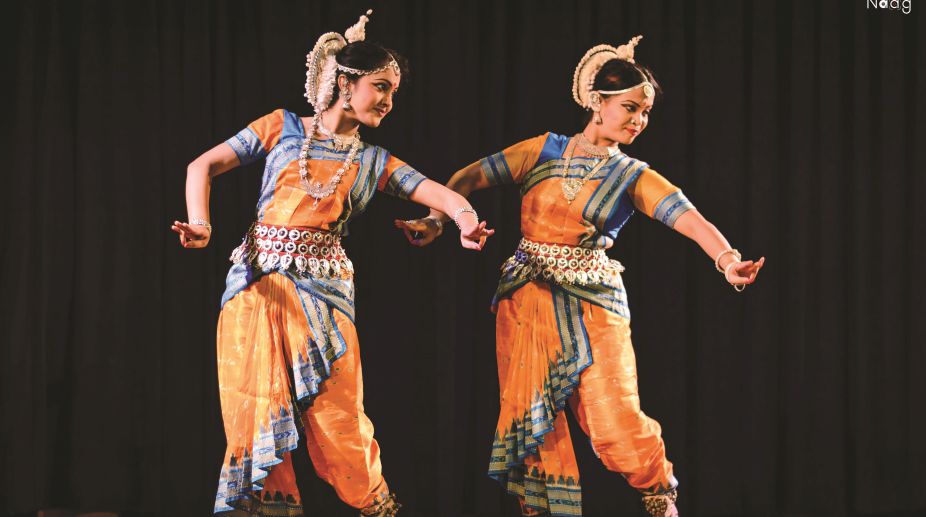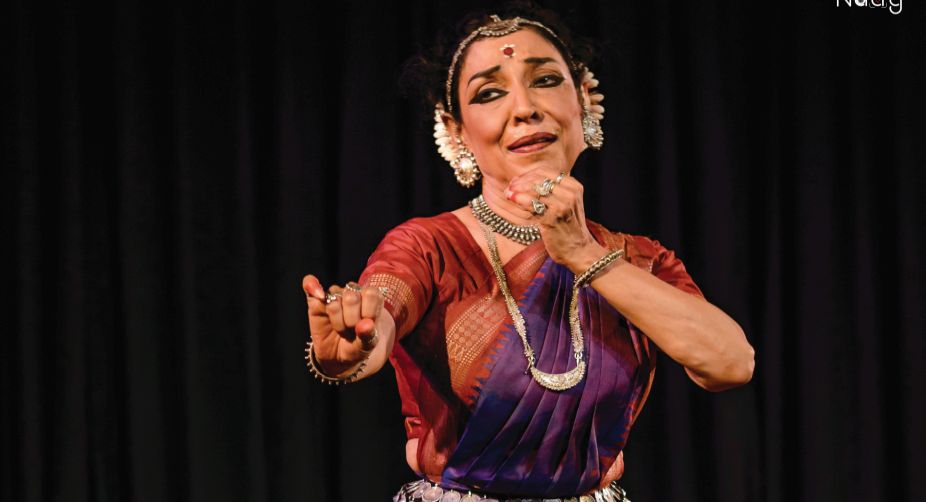Imbued with unbridled verve
A young Odissi dancer to watch out for is Diptimayee Sahoo and she recently performed with great aplomb in Bhubaneswar.
Debadhara, highlighting guru-shishya parampara, presented learned Gurus and their dedicated disciples from six different dance styles. A review by Manjari Sinha

Disciples of Guru Aloka Kanungo.
Debadhara, upholding the “Dhara”, or lineage, of Guru Debaprasad Das and his specific style of Odissi, was founded by Guru Binayak Panda in the year 2003. Their latest endeavour, the Guru Shishya Samman Festival, underlined the importance of true transmission of our arts.
The two-day festival honoured the learned Gurus and their dedicated disciples from six different dance styles and showcased their performances at the India International Centre.
The inaugural evening opened with the senior Odissi Guru Aloka Kanungo, and her disciples Suvra Maity and Paulomi Chakraborty, who began with Taal-Madhuri. The Odissi duet proved that Taal, conventionally associated with percussion instruments, can also have the “Madhuri”, or melodiousness, of a raga like Yaman Kalyan, on which it was based.
Advertisement
The Abhinaya piece “Arere Nando re Suto…” written and choreographed by Guru Aloka Kanungo herself, was composed by Prof Ramhari Dasa, interspersed with Shabda-Swara-Path, Kavitta and rhythmic patterns by Guru Dhaneshwar Sai in talas Ektali and Khemta.
The Odia song depicted adorable pranks of naughty Krishna, played by Aloka herself, being punished by gopis (Suvra and Paulomy). The piece opened with a solo by Aloka wearing the peacock feather like Krishna, dancing to intricate rhythm and cautiously looking for the gopis while stealing their buttermilk, before the gopis enter the stage.
Aloka Kanungo and her disciples concluded their Odissi performance with Dash-Mahavidya, where the added effect of temple bells and percussions like Khol created a devotional aura to the musical score for the sculpturesque freezes of the ten incarnations of Devi, the Chinnamasta, Kali, Tara, Shodashi, Bhuvaneshwari, Bhairavi, Dhumavati, Baglamukhi, Matangi and Kamala.

Kuchipudi by Guru Jayarama Rao and his talented disciples T Reddy Laxmi, Aditi Gupta and Abhirami Ajith, came next. The melodious Mohanam Alap on the Flute created a perfect ambience for the opening Vinayaka Kauthuvam, performed by his disciples.
Guru Jayarama Rao’s impressive enactment of the demon king Hiranyakashipu with all his might and valour in Hiranyakashipu Pravesha Daruvu, brought back the authentic aura of the traditional Prahlada Natakam. The dramatic music, set to Aditalam in raga Saveri, enhanced his virile persona with the intimidating use of percussions and Turahi-like instruments.
The gifted disciple T Reddy Laxmi next did her guru proud, interpreting the Swathi Thirunal Bhajan “Aaj aaye Shyam Mohan…” composed by the Maharaja in raga Shyam-Kalyan. Laxmi’s arresting abhinaya in episodes like the Draupadi Cheer Haran was eloquent.
Guru Saswati Sen, herself the seniormost disciple of Pt Birju Maharaj, excelled in her solo Kathak performance, dancing tala Vakra-Vasant, a challenging cycle of nine-and-a-half beats. Opening with Guru Vandana for her legendary Guru sitting in front, she presented the choicest compositions in this remarkable Tala.
Her effortless ease in executing the daunting Chakkardar “Takit takit dhin…”, the Anagat where the Sam comes a split second prior to its actual beat, the variety in combination of 3x3x3½, the Parmelu and the slickly executed 21 pirouettes, before she moved on to the conventional Teentala.
In this usual Tala of Kathak, she showcased most unusual stuff, including the Farmaishi Tihais and attractive visual aspect of rhythm in throwing and catching the ball or depicting games like Hockey, the love talk between a Sardar-ji and a Japanese girl using just the Kathak Bols, or syllables; and all of it keeping the Tala and Matras intact with an unerring eye on the inevitable Sam.
The mesmerising Abhinaya on a Bandishi Thumri of Nazar Piya “Aal mori kalai muruk gayi…”, depicted three types of nayikas (heroines) ~ Mugdha or Agyat-Yauvana, the young innocent one; Madhya who knows but feels shy; and the Praudha, who knows it all and enjoys herself.
Her disciples Elisha and Sunny Sisodia had opened their segment with Ardhanarishwara Kavitta, composed by Pt Birju Maharaj and choreographed by Saswati, interspersing the traditional Tode, Tukde, Paran et al.
The second evening opened with Guru Madhavi Mudgal and her disciples presenting Odissi in solo and group performances. Madhavi’s Odissi is a blend of innate grace and complete command on rhythm, was established right from her opening Nataraja, written by late Mayadhar Mansingh before she came to the Odia poem composed by Pt Gopal Chandra Panda in raga Rasa-Manjari, offering aesthetic delight the “Rasanubhava” to Rasikas with her subtle Abhinaya.
Guru Madhavi Mudgal presented three of her well-groomed disciples in Shalaka, Shobha and Dipika, performing Ragamalika Pallavi, a garland of Ragas ~ Hamir, Kamod, Kedar and Chhayanat ~ sharing similar fragrance, coming back on the mesmerising Mukhda of Hamir, imaginatively composed by Pt Madhup Mudgal to suit the refreshingly vibrant choreography of Madhavi.
Mohiniyattam by Guru Bharati Shivaji and disciples Vani and Samrita had Mukhachalan in Ragamalika and Jayadeva’s Ashtapadis in ragas Kedar Gaula and Shree, before Guru Geeta Chandran and disciples Amrita Shruti, Radhika and Madhura took the festival to its climax with their breathtaking Bharatanatyam Varnam “Vanajaaksha…” soulfully sung in raga Bihag by Sudha Raghuraman to match the myriad hues of the captivating choreography.
Advertisement